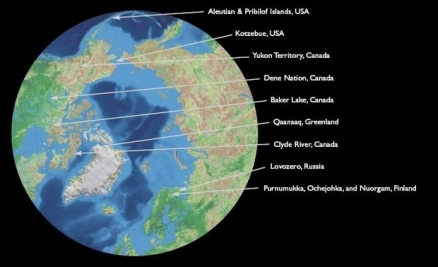Climate change and the Saami case study
This is Section 3.4.8 of the Arctic Climate Impact Assessment; one of nine Arctic climate change case studies using indigenous knowledge. Case Study Author: Climate Change and the Saami: Elina Helander
Elina Helander is a researcher at the Arctic Centre of the University of Lapland as well as a Saami from Ochejohka. She took part in the preparation and community activities for the documentation work that produced the Sapmi case study in Section 3.4.7 (Climate change and the Saami case study) of the full Arctic Climate Impact Assessment (ACIA) report.
The Saami have an ecological knowledge of their own, rooted in the traditional way of life. They have their own knowledge derived from experience, long-term observation, and the utilization of natural resources. This knowledge is best expressed and transmitted through the Saami language. Saami ecological knowledge goes beyond observation and documentation because it is a precondition for their survival. Particularly interesting is the fact that indigenous people like the Saami have long-term experience in adaptation. People in the villages are worried as they face global changes. The Saami are used to combining different economic activities, such as berry picking, reindeer herding, fishing, hunting, trapping, and handicraft. If the changes are sudden, accumulate rapidly, and have impacts on all or most of local resources, and if the resource base is scarce, then the problems start to show themselves immediately. Many claim that the weather has become warmer, and especially the fall and early winter are warm. During the recent years, the ground has not frozen properly in the fall, and there has been little rain in September. There are many salmon rivers and lakes in the Utsjoki area where I come from. When the ground does not freeze in the fall, and there is little snow during the winter, there is very little water in late May and early summer in the rivers and lakes. Then, of course, with little rain during June, the rivers are almost dry and the fish cannot go upriver. But during the recent years, it has happened that in July there are heavy rains. Consequently, the amount of water increases enormously and it becomes impossible to fish in small salmon (Salmo salar) rivers. Many herders and subsistence hunters claim that there are no winds anymore. Wind has some positive effects. For instance, wind gathers the snow to certain spots. In other spots there is little snow and it is then easy for the reindeer to dig through where the amount of snow is small. The wind can also make the snow soft, but on the other hand, the extremely strong wind, guoldu in Saami, makes the snow hard. During the recent years, the weather has started to change rapidly, so that sudden shifts take place. There are no longer stable periods of a cold weather type. It has also become more difficult to predict the coming weather. People are more careful when moving across lakes and rivers. In our area the moose migrate in early November from north to south, but they can be hindered from doing this if there is no ice in the rivers and lakes. There must come about a radical change regarding the ecological awareness in humanity if we want to do something positive regarding the changes that occur and are predicted to come. When talking about the snow change, we should not only monitor and accept the changes. We have to resist the global changes when resistance is imperative, i.e., when the changes made by man cause serious damage to nature, societies, and people.
3.1. Introduction (Climate change and the Saami case study)
3.2. Indigenous knowledge
3.3. Indigenous observations of climate change
3.4. Case studies (Climate change and the Saami case study)
3.4.1. Northwest Alaska: the Qikiktagrugmiut3.5. Indigenous perspectives and resilience
3.4.2. The Aleutian and Pribilof Islands region, Alaska
3.4.3. Arctic Athabaskan Council: Yukon First Nations
3.4.4. Denendeh: the Dene Nation’s Denendeh Environmental Working Group
3.4.5. Nunavut
3.4.6. Qaanaaq, Greenland
3.4.7. Sapmi: the communities of Purnumukka, Ochejohka, and Nuorgam
3.4.8. Climate change and the Saami
3.4.9. Kola: the Saami community of Lovozero
3.6. Further research needs
3.7. Conclusions (Climate change and the Saami case study)
